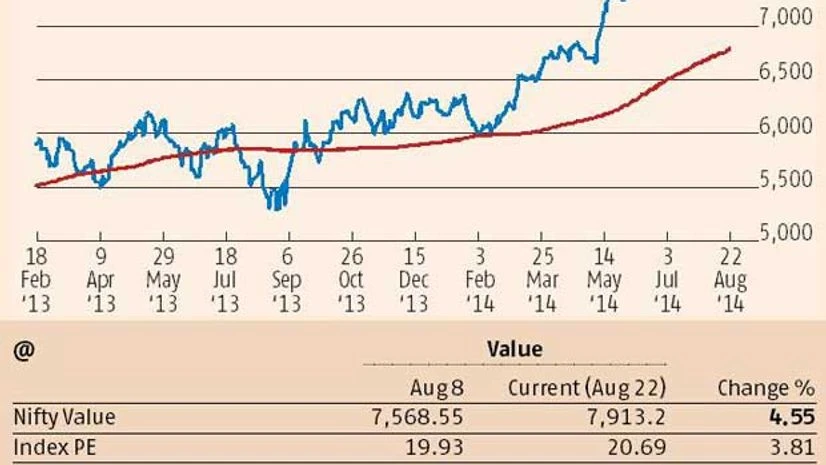In his "General Theory", Keynes described "spontaneous optimism" and "urge to action" as "animal spirits". Those spirits are back in evidence in a market bubbling with a mix of renewed consumer confidence and investor enthusiasm.
In the past two months, equity mutual funds have seen strong inflows from domestic retail. The Q1, 2014-15 results, were buoyed by good performance b the fast-moving consumer goods sector and a recovery in automobiles - both consumption-driven sectors.
Some of those household savings are reallocating from fixed deposits to mutual funds. But ironic as it seems, some retail investors are returning to safety by parking cash with normal asset management concerns invested in listed businesses. They have been burnt badly by indulging a preference for so-called para-bankers and outright fraudsters, if one goes by cases such as Saradha, Sahara and PACL.
Retail investor confidence has translated to net buying by domestic institutional investors (DIIs). August has seen domestic institutions pick up over Rs 1,500 crore - their first positive month since February. Net-net, DIIs have sold about Rs 31,000 crore this calendar year. The bull run has been driven by net foreign institutional investor (FII) buying of over Rs 60,000 crore.
Since the FIIs remain positive and the DIIs have started buying, there may be a major upside. Indeed, the indices have been hitting new highs with regularity. Valuations suggest that the bull run could go much further. At a PE of 20.7 and a P-Book value ratio of 3.4, the Nifty is not much above its long-term averages of 18.4 and 2.9. If institutional attitude is uniformly bullish, the market must go up. The last bull run peaked at index PEs of 27-plus.
There is a rationale for the enthusiasm. The macroeconomic indicators suggest the worst is over. Inflation has moderated to some extent. The Index of Industrial Production was positive for the last three months, rising by about 3.9 per cent through April-June 2014.

The external indicators are much improved. The current account deficit (CAD) dropped to $32 billion or 1.7 per cent of GDP in 2013-14. It's expected to stay within the bounds of two per cent of GDP ($39-40 billion) in 2014-15. Those numbers from the Ministry of Commerce incidentally imply that India's GDP will increase by about 2.4 per cent in dollar terms in 2014-15. (The economy shrank in dollar terms in 2013-14.)
Brokerages like Barclays and Standard Chartered are now making projections of six per cent GDP growth in 2014-15. That is at the upper limit of the Reserve Bank of India (RBI)'s projections and higher than the 5.8 per cent mentioned recently by Finance Secretary Arvind Mayaram. The MoSPI estimates of Q1, GDP growth will be released on August 29.
After two fiscals of sub-five per cent growth, six per cent would be a big turnaround. If we offset the CAD numbers implying 2.5 per cent GDP growth in dollar terms, versus the six per cent rupee-denominated growth assumptions, the rupee is expected to fall by about three to four per cent. Most traders are assuming the dollar-rupee will range trade between 58-62 at the moment, which gels, more or less, with these "meta-projections".
More than the numbers, there is also the enthusiasm or animal spirits generated by a new government. The next set of triggers for market moves could be the announcement of some big deals during the prime minister's visits to Japan and the US. Narendra Modi has already announced multiple projects across India, mainly in the states going to the polls in the recent future.
However, despite improved sentiments, the financial situation remains shaky. Cases like Syndicate Bank and Bhushan Steel suggest that there could be a serious understatement of debt-stresses. After all, Bhushan Steel has Rs 40,000 crore of debt (including Rs 35,000 crore of bank debt owed to 51 banks) outstanding and this is not classified as non-performing assets (NPAs). How many more such cases are there?
Recent reports suggest that the reporting of NPAs from the power sector in particular, and infrastructure in general, may be seriously understated. Power plants need not service debt until they are officially operational. Financially stressed plants are postponing launches in order to delay the start of repayments. Those loans are marked "standard".
The RBI annual report states gross NPAs are at about four per cent of total advances. Taken together with restructured loans (5.9 per cent) and understated non-performing loans (reputedly over four per cent), banks could be in very dangerous territory. Most of the dubious assets are with public sector banks. The RBI will have its task cut out managing the recapitalisation of balance sheets, plus raising additional capital to meet Basel-III norms. The National Democratic Alliance's big thrust into infrastructure could, therefore, be make or break for the banking sector.
On the global front, the latest European GDP estimates suggest that Germany is headed down and France is stagnant. Italy and Spain are still in recession. So, EU will not contribute to global growth but, of course, the European Central Bank may well contribute to global liquidity if it starts its own version of quantitative easing.
The US has seen fairly robust growth in the last quarter and the Fed will continue to taper. Japan saw GDP shrink by an annualised 6.8 per cent as a new sales tax kicked in. If this decline is not temporary, Abenomics would become synonymous with seppoku. Crude prices remain soft despite the madness in Iraq and Libya.
The major market indices continue to head up. The Nifty is eyeing the rarefied atmosphere above 8,000. A major reversal in sentiment, if it happens at all, could be triggered by external supply shocks if crude prices suddenly rise. Or, there might be a downgrade of the Indian bank sector.
Disclaimer: These are personal views of the writer. They do not necessarily reflect the opinion of www.business-standard.com or the Business Standard newspaper

)
